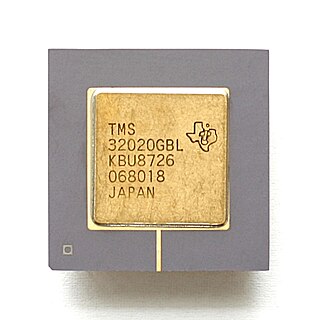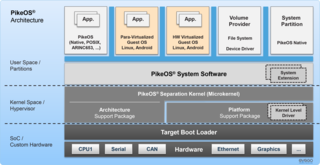
In computer science, a microkernel is the near-minimum amount of software that can provide the mechanisms needed to implement an operating system (OS). These mechanisms include low-level address space management, thread management, and inter-process communication (IPC).
A real-time operating system (RTOS) is an operating system (OS) for real-time computing applications that processes data and events that have critically defined time constraints. An RTOS is distinct from a time-sharing operating system, such as Unix, which manages the sharing of system resources with a scheduler, data buffers, or fixed task prioritization in a multitasking or multiprogramming environment. Processing time requirements need to be fully understood and bound rather than just kept as a minimum. All processing must occur within the defined constraints. Real-time operating systems are event-driven and preemptive, meaning the OS can monitor the relevant priority of competing tasks, and make changes to the task priority. Event-driven systems switch between tasks based on their priorities, while time-sharing systems switch the task based on clock interrupts.
In distributed computing, a remote procedure call (RPC) is when a computer program causes a procedure (subroutine) to execute in a different address space, which is written as if it were a normal (local) procedure call, without the programmer explicitly writing the details for the remote interaction. That is, the programmer writes essentially the same code whether the subroutine is local to the executing program, or remote. This is a form of client–server interaction, typically implemented via a request–response message-passing system. In the object-oriented programming paradigm, RPCs are represented by remote method invocation (RMI). The RPC model implies a level of location transparency, namely that calling procedures are largely the same whether they are local or remote, but usually, they are not identical, so local calls can be distinguished from remote calls. Remote calls are usually orders of magnitude slower and less reliable than local calls, so distinguishing them is important.

In computer science, inter-process communication (IPC), also spelled interprocess communication, are the mechanisms provided by an operating system for processes to manage shared data. Typically, applications can use IPC, categorized as clients and servers, where the client requests data and the server responds to client requests. Many applications are both clients and servers, as commonly seen in distributed computing.
Nucleus RTOS is a real-time operating system (RTOS) produced by the Embedded Software Division of Mentor Graphics, a Siemens Business, supporting 32- and 64-bit embedded system platforms. The operating system (OS) is designed for real-time embedded systems for medical, industrial, consumer, aerospace, and Internet of things (IoT) uses. Nucleus was released first in 1993. The latest version is 3.x, and includes features such as power management, process model, 64-bit support, safety certification, and support for heterogeneous computing multi-core system on a chip (SOCs) processors.

The Blackfin is a family of 16-/32-bit microprocessors developed, manufactured and marketed by Analog Devices. The processors have built-in, fixed-point digital signal processor (DSP) functionality supplied by 16-bit multiply–accumulates (MACs), accompanied on-chip by a microcontroller. It was designed for a unified low-power processor architecture that can run operating systems while simultaneously handling complex numeric tasks such as real-time H.264 video encoding.

The OMAP family, developed by Texas Instruments, was a series of image/video processors. They are proprietary system on chips (SoCs) for portable and mobile multimedia applications. OMAP devices generally include a general-purpose ARM architecture processor core plus one or more specialized co-processors. Earlier OMAP variants commonly featured a variant of the Texas Instruments TMS320 series digital signal processor.

FreeRTOS is a real-time operating system kernel for embedded devices that has been ported to 35 microcontroller platforms. It is distributed under the MIT License.

Texas Instruments TMS320 is a blanket name for a series of digital signal processors (DSPs) from Texas Instruments. It was introduced on April 8, 1983 through the TMS32010 processor, which was then the fastest DSP on the market.
The Local Inter-Process Communication is an internal, undocumented inter-process communication facility provided by the Microsoft Windows NT kernel for lightweight IPC between processes on the same computer. As of Windows Vista, LPC has been rewritten as Asynchronous Local Inter-Process Communication in order to provide a high-speed scalable communication mechanism required to efficiently implement User-Mode Driver Framework (UMDF), whose user-mode parts require an efficient communication channel with UMDF's components in the executive.

The Texas Instruments DaVinci is a family of system on a chip processors that are primarily used in embedded video and vision applications. Many processors in the family combine a DSP core based on the TMS320 C6000 VLIW DSP family and an ARM CPU core into a single system on chip. By using both a general-purpose processor and a DSP, the control and media portions can both be executed by separate processors.

PikeOS is a commercial, hard real-time operating system (RTOS) that offers a separation kernel based hypervisor with multiple logical partition types for many other operating systems (OS), each called a GuestOS, and applications. It enables users to build certifiable smart devices for the Internet of things (IoT) according to the high quality, safety and security standards of different industries. For safety and security, critical real-time applications on controller-based systems without memory management unit (MMU) but with memory protection unit (MPU) PikeOS for MPU is available.

Fiwix is an operating system kernel based on the UNIX architecture and fully focused on being POSIX compatible. It is designed and developed mainly as a hobbyist operating system, but it also serves for educational purposes. It runs on the i386 hardware platform and is compatible with a good base of existing GNU applications. It follows the System V Application Binary Interface and is also Linux 2.0 System Call ABI mostly compatible

Code Composer Studio is an integrated development environment to develop applications for Texas Instruments embedded processors.
TI-RTOS is an embedded tools ecosystem created and offered by Texas Instruments (TI) for use across a range of their embedded system processors. It includes a real-time operating system (RTOS) component named TI-RTOS Kernel, networking connectivity stacks, power management, file systems, instrumentation, and inter-processor communications like DSP/BIOS Link. It is free and open-source software, released under a BSD license.
BeRTOS is a real-time operating system designed for embedded systems.

OpenComRTOS is a commercial network-centric, formally developed real-time operating system (RTOS), aimed mainly at the embedded system market.
RPMsg is a protocol enabling inter-processor communication inside multi-core processors.
Cap’n Proto is a data serialization format and Remote Procedure Call (RPC) framework for exchanging data between computer programs. The high-level design focuses on speed and security, making it suitable for network as well as inter-process communication. Cap'n Proto was created by the former maintainer of Google's popular Protocol Buffers framework and was designed to avoid some of its perceived shortcomings.










